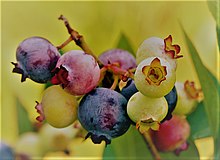Blueberry
| Blueberry | |
|---|---|
 |
|
| Vaccinium corymbosum | |
| Scientific classification | |
| Kingdom: | Plantae |
| (unranked): | Angiosperms |
| (unranked): | Eudicots |
| (unranked): | Asterids |
| Order: | Ericales |
| Family: | Ericaceae |
| Genus: | Vaccinium |
| Section: |
Cyanococcus Rydb. |
| Species | |
|
See text |
|

|
|
| Nutritional value per 100 g (3.5 oz) | |
|---|---|
| Energy | 240 kJ (57 kcal) |
|
14.49 g
|
|
| Sugars | 9.96 g |
| Dietary fiber | 2.4 g |
|
0.33 g
|
|
|
0.74 g
|
|
| Vitamins | |
| Vitamin A equiv. |
(0%)
32 μg80 μg
|
| Vitamin A | 54 IU |
| Thiamine (B1) |
(3%)
0.037 mg |
| Riboflavin (B2) |
(3%)
0.041 mg |
| Niacin (B3) |
(3%)
0.418 mg |
| Pantothenic acid (B5) |
(2%)
0.124 mg |
| Vitamin B6 |
(4%)
0.052 mg |
| Folate (B9) |
(2%)
6 μg |
| Vitamin C |
(12%)
9.7 mg |
| Vitamin E |
(4%)
0.57 mg |
| Vitamin K |
(18%)
19.3 μg |
| Minerals | |
| Calcium |
(1%)
6 mg |
| Iron |
(2%)
0.28 mg |
| Magnesium |
(2%)
6 mg |
| Manganese |
(16%)
0.336 mg |
| Phosphorus |
(2%)
12 mg |
| Potassium |
(2%)
77 mg |
| Sodium |
(0%)
1 mg |
| Zinc |
(2%)
0.165 mg |
| Other constituents | |
| Water | 84 g |
|
|
|
|
|
| Percentages are roughly approximated using US recommendations for adults. Source: USDA Nutrient Database |
|
See text
Blueberries are perennial flowering plants with indigo-colored berries from the section Cyanococcus within the genus Vaccinium (a genus that also includes cranberries, bilberries and grouseberries). Species in the section Cyanococcus are the most common fruits sold as "blueberries" and are native to North America (commercially cultivated highbush blueberries were not introduced into Europe until the 1930s).
Blueberries are usually erect, prostrate shrubs that can vary in size from 10 centimeters (3.9 in) to 4 meters (13 ft) in height. In the commercial production of blueberries, the smaller species are known as "lowbush blueberries" (synonymous with "wild"), while the larger species are known as "highbush blueberries".
The leaves can be either deciduous or evergreen, ovate to lanceolate, and 1–8 cm (0.39–3.15 in) long and 0.5–3.5 cm (0.20–1.38 in) broad. The flowers are bell-shaped, white, pale pink or red, sometimes tinged greenish. The fruit is a berry 5–16 millimeters (0.20–0.63 in) in diameter with a flared crown at the end; they are pale greenish at first, then reddish-purple, and finally dark purple when ripe. They are covered in a protective coating of powdery epicuticular wax, colloquially known as the "bloom". They have a sweet taste when mature, with variable acidity. Blueberry bushes typically bear fruit in the middle of the growing season: fruiting times are affected by local conditions such as altitude and latitude, so the peak of the crop can vary from May to August (in the northern hemisphere) depending upon these conditions.
...
Wikipedia
